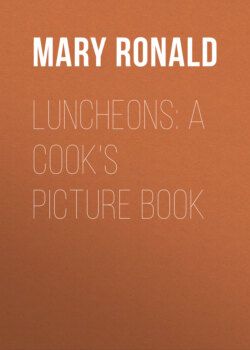Читать книгу Luncheons: A Cook's Picture Book - Mary Ronald - Страница 7
На сайте Литреса книга снята с продажи.
FISH
ОглавлениеTable of Contents
As fish dishes rank with any other kind in point of attractiveness, and are open to almost as great a variety of garnishing as are meats, the same general remarks apply to them. The matter of shape and color here, too, has to be considered. A boiled fish dropping to pieces from over-cooking, or bereft of its head or tail, is an unsightly dish. It is permitted to serve fish au naturel, even going so far as to simulate swimming. This is done by propping it with a whole carrot laid inside, which gives the fish enough rigidity to stand upright. Illustration No. 8 shows a fish served in this way. The garnishing is white rings of hard-boiled egg, holding sprigs of parsley, laid along the back. A slice of lemon sprinkled with and surrounded by parsley, giving the effect of a medallion, is placed against the side of the fish. A fish to be baked may be twisted like the letter S to make it stand upright. A boiled fish, whether served whole or in part, should appear clean. No scum from the kettle should be suffered to remain on it, and no water should drip from it into the platter. A folded napkin is usually placed under boiled fish to insure dryness.
Boiled potatoes are ordinarily served with boiled fish, and may be used for garnishing, if cut into balls and cooked so that they are very white and mealy. Parsley gives color and also a sense of freshness. It may be used in large bunches, especially when the fish is cut, or on creamed fish dishes.
NO. 9. BOILED SECTION OF FISH COVERED WITH WHITE SAUCE AND GARNISHED WITH CHOPPED PARSLEY AND POTATO BALLS.
Illustration No. 9 shows a middle cut of fish with potato and parsley decoration. The fish being cod, the flesh is not sufficiently white to be attractive, and so it is masked with white sauce, then sprinkled with chopped parsley. Had the fish been halibut, the sauce would have been omitted. Hard-boiled eggs are an excellent accompaniment for boiled fish, and when not used in the sauce may be supplied in the garnishing. Creamed fish is pretty with the top made golden with crumbed yolks.
Fried fish should have a lemon color and look clean, dry, and bright, not black or greasy. The color is secured by dipping them in milk, then rolling in flour and frying in smoking-hot fat; or, if eggs and crumbs are used, having white, fresh crumbs grated from the stale loaf. Fish to be fried is often cut into slices, or into fillets, but small fish need not be cut and so lose their character. Smelts are sometimes turned into rings, or are laid open and the head drawn through a slit cut in the back. Different ways of dressing them give variety, and make dishes ornamental from form alone. If potatoes are served with fried fish, they should be cut into balls and fried. Lemons are indispensable with fried or broiled fish. They are frequently sliced, but are better cut in quarters so as to give more of the juice, which is needed for condiment. Lemon sprinkled with chopped parsley is very pretty.
Broiled fish is improved by being spread with maître d’hôtel butter. This gives it a moist appearance, and is the best possible sauce for it; at the same time the parsley in the sauce helps to garnish the dish. Watercress placed around the fish completes the garnishing and makes the dish perfect. Lemon and watercress are the best condiments for any fried or broiled dish. Baked fish will not bear more than a few sprigs of parsley as garnishing.
Lobster coral is much esteemed on account of its brilliant color, and when lobster is served it is well to use it as a garnish. It may be sprinkled over the whole surface of a lobster dish, or be arranged in lines or dots as the circumstances suggest. Shrimps, prawns, and crawfish make good garnishes for any fish, whether it is served hot or cold.
When dishes are to be passed, the dishing and garnishing should be such that the portions are easily distinguishable.
An amusing story is told by a scientist of the predicament in which he was placed when the guest of honor at an English table. He was a man of simple habits in his home, and was very near-sighted. Elaborately garnished dishes were passed to him first, as he sat at the right of the host, and he had to break the construction of what he was pleased to call architectural or master-builder’s dishes, and this without knowing where their keystone lay, or of what they were composed. He was thus obliged to make public exhibition of his awkwardness, as well as betray ignorance in that branch of his own business, which left him unable to recognize biological specimens when they had evolved into their highest development in the hands of the cook. This story serves as an important hint that no dish should be entirely disguised. A lobster should still be a lobster in form or suggestion, however it is prepared. For example, should it be served in chops, a claw pressed into one end would not only carry out the form of a chop, but would also designate the dish. There is generally something that can be reserved from an article which loses its shape in cooking that may be used to garnish the dish and act as a kind of label.
The garnishes are:
For Vegetables
